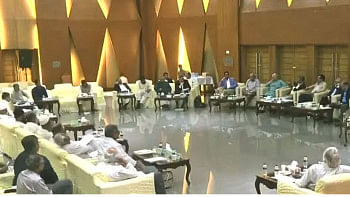The dire effects of dowry
What is the cost of a life? While there have been ample studies done by social and economic groups to discover the mystery, in rural Bangladesh this can sometimes turn out to be very little. A report by The Daily Star in January 2004 depicts that when a greedy husband in Chapainawabganj failed to realize a dowry claim of Tk 20,000 ($339) from his wife Marina's family, he hired a gang of three men for Tk 300 ($5) to help him kill her, just after 22 days of their marriage. Being a new bride provided no cushion to Marina from the grisly hands of dowry related violence.
The practice of dowry is based on the age-old notion that women are inferior to men; this is translated into the fact that since women are burdens, an economic incentive in the form of money or assets must accompany the girl during marriage to compensate for her weaknesses. Needless to say, if the girl possesses a dark complexion or has a physical disability, a bargain hunting groom will not hesitate to take full advantage and ask for a significantly higher amount of dowry.
The tale of dowry does not end here; in fact this leads to further violence on women after the marriage has taken place. In most cases, the husband will brutally torture the wife if the full dowry has not been given to him or unleash his wrath for more dowries even after conditions have been met during the wedding. One of the main reasons why women cannot abscond from their ill-fate is poverty. Advocate Sultana Kamal, executive director of Ain O Shalish Kendro, said “Dowry is strongly linked to women's poverty. Poverty makes women vulnerable”. Poverty also restricts women from going back to their parents' houses as they may not be economically able to accommodate her; in addition, there is a strong stigma attached to it.
Studies have found that dowry is one of the main reasons for domestic violence. Refusal to provide dowry leads to serious physical abuse, deaths and sometimes even provokes women to commit suicide. Dowry related violence against women has been on the rise. According to Odhikar's Human Rights Reports 2011 and 2012, a total of 808 hapless women were victims of blatant dowry-related abuse in 2012. This is four times the number in 2007- indicating the lack of social and institutional attention being given into this matter. Although there have been some laws enacted to recede such violence against women such as the Dowry Prohibition Act, the number of violence-victims continues unabated which clearly demonstrates that such laws do not have the capacity to bring this situation under control.
Sometimes the perpetrators often pay off the officials to avoid arrest. Mohammad Ashrafuzzaman, a programme officer of Asian Legal Resource Centre said that “The perpetrators manipulate the system and ultimately the problem continues”. It is also important to understand that the numbers related to physical abuses of women are an underestimation as abuses of many women go unreported. Fear of further attack by their husbands keeps many women from grasping the hand of law or even discussing about it with others.
A high number of dowry-related killings of women every year is indeed daunting; Odhikar reports that 305 women were killed in 2011, though the number stood at 273 in 2012, this only reflects a 12 percent decrease. However, victims who were physically abused increased by 3 times in 2012 compared to 2011. The notion of practicing dowry needs to be eradicated immediately. If not, it will continue to be used as an instrument for inflicting torture on women which will lead to more and more deaths every year. The third goal of United Nation's Millennium Development which promotes gender equality and empowering women will not be fully realized if the practice of dowry continues persistently. If dowry remains in the equation then gender equality will ceaselessly remain an illusion.
The writer is the head of research of The Daily Star and can be reached at [email protected]


 For all latest news, follow The Daily Star's Google News channel.
For all latest news, follow The Daily Star's Google News channel. 



Comments